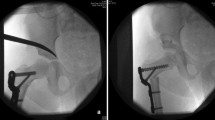Abstract
Introduction
This paper presents our initial findings on the use of arthroscopic hip reduction in conjunction with acetabuloplasty to treat patients of walking age who had congenital dislocation of the hip.
Materials and methods
Arthroscopic reduction with acetabuloplasty was performed on nine children of walking age with nine dislocated hips. The average age of the patients was 21.4 months (14–41 months). Arthroscopic reduction was performed using a two-portal method with a 2.7-mm mini cannulated arthroscopic instrument. We used a subadductor portal and a high anterolateral portal. The obstacles preventing reduction—hypertrophic teres ligament, pulvinar, capsular constriction, hypertrophic transverse ligament—were eliminated.
Results
We treated one grade 4 hip, four grade 3 hips and four grade 2 hips, as classified by Tönnis. We were able to perform arthroscopic reduction on all of the hips. The main obstacles preventing reduction were a capsular constriction and a hypertrophic teres ligament. During the investigation period, which averaged 15.4 months (6–29 months), no repeat dislocation occurred. According to the Tönnis classification system for avascular necrosis, there were two cases of a grade 2 necrosis of the femoral head. The average preoperative AC angle was 40° (34°–47°). The average AC angle at the follow-up examination was 18.7° (11°–27°).
Conclusions
We can conclude that the standardized arthroscopic surgical technique presented here can also be used to safely perform arthroscopic reduction in toddlers. The new arthroscopic method is an alternative to open reduction for selective hip dislocations. We believe this approach can be used to treat dislocated hips that are classified as grades 2 and 3 dislocations according Tönnis. Early results are promising. Medium-term results are needed to make a definitive statement on the rates of necrosis of the femoral head.






Similar content being viewed by others
References
Wirth T, Stratmann L, Hinrichs F (2004) Evolution of late presenting developmental dysplasia of the hip and associated surgical procedures after 14 years of neonatal ultrasound screening. J Bone Joint Surg Br 86:585–589
Ihme N, Altenhofen L, von Kries R, Niethard FU (2008) Hüftultraschallscreening in Deutschland: Resultate und ein Vergleich mit anderen Screeningmethoden. Der Orthopäde 37:541–549
Mootha AK, Saini R, Dhillon M, Aggarwal S, Wardak E, Kumar V (2010) Do we need femoral osteotomy in DDH in early walking age group? A clinico-radiological correlation study. Arch Orthop Trauma Surg 130:853–858
Arslan H, Kapukaya A, Bekler HI, Neemioglu S (2007) Is varus osteotomy necessary in one-stage treatment of developmental dislocation of the hip in older children. J Child Orthop 1:291–297
Wenger DR, Mubarak SJ, Henderson PC, Miyanji F (2008) Ligamentum teres maintenance and transfer as a stabilizer in open reduction for pediatric hip dislocation: surgical technique and early clinical result. J Child Orthop 2(3):177–185
Gunel U, Daglar B, Tasbas BA, Delialioglu O, Bayrakci K (2012) Results of Tönnis-type acetabuloplasty in patients with developmental hip dysplasia. J Orthop Sci 17:705–709
Herring TM (2008) Tachdjian’s pediatric orthopaedics. Saunders, Philadelphia
McCarthy JJ, MacEwen GD (2007) Hip arthroscopy for the treatment of children with hip dysplasia: a preliminary report. Orthopedics 30:262–264
Eberhardt O, Fernandez FF, Wirth T (2012) Arthroscopic reduction of the dislocated hip in infants. J Bone Joint Surg Br 94:842–847
Bulut O, Öztürk H, Tezeren G, Bulut S (2005) Arthroscopic-assisted surgical treatment for developmental dislocation of the hip. Arthroscopy 21:574–579
Tönnis D (1984) Die angeborene Hüftdysplasie und Luxation im Kindes- und Erwachsenenalter. Springer, Berlin Heidelberg New York
Salter RB, Kostiuk J, Dallas S (1969) Avascular necrosis of the femoral head as a complication of treatment for congenital dislocation of the hip in young children: a clinical and experimental investigation. Can J Surg 12:44–61
Gabuzda GM, Renshaw TS (1992) Reduction of congenital hip dislocation. J Bone Joint Surg 74:624–631
Okano K, Yamada K, Takahashi K, Enomoto H, Osaki M, Shinido H (2009) Long-term of Ludloff’s medial approach for open reduction of developmental dislocation of the hip in relation to the age at operation. Int Orthop 33:1391–1396
Pospischill R, Weninger J, Ganger R, Altenhuber J, Grill F (2012) Does open reduction of the developmental dislocated hip increase the risk of osteonecrosis? Clin Orthop Relat Res 470:250–260
Morcuende JA, Meyer DA, Dolan LA, Weinstein SL (1997) Long-term outcome after open reduction through an anteromedial approach for congenital dislocation of the hip. J Bone Joint Surg 79:81–817
Wenger DR, Lee CS, Kolman B (1995) Derotational femur shortening for developmental dislocation of the hip: special indications and results in the child younger than 2 years. J Pediatr Orthop 15:768–779
Özturk H, Oztemür Z, Bulut O, Tezeren G, Bulut S (2013) Arthroscopic-assisted surgical treatment for developmental dislocation of the hip before the age of 18 months. Arch Orthop Trauma Surg 133:1289–1294
Bhuyan BK (2012) Outcome of one-stage treatment of developmental dysplasia of the hip in older children 46:548–555
Segal LS, Boal DK, Borthwick L, Clark MW, Localio AR, Schentker EP (1999) Avascular necrosis after treatment of DDH: the protective influence of the ossific nucleus. J Ped Orthop 19:177–184
Roposch A, Odeh O, Doria AS, Wedge JH (2011) The presence of an ossific nucleus does not protect against osteonecrosis after treatment of developmental dysplasia of the hip. Clin Orthop Relat Res 469:2838–2845
Sibinski M, Synder M, Domzalski M, Grzegorzewski A (2004) Risk factors for avascular necrosis after closed hip reduction in developmental dysplasia of the hip. Orthop Traumatol Rehabil 28:60–66
Conflicts of intererst
There are no conflicts of interest.
Author information
Authors and Affiliations
Corresponding author
Rights and permissions
About this article
Cite this article
Eberhardt, O., Wirth, T. & Fernandez, F.F. Arthroscopic reduction and acetabuloplasty for the treatment of dislocated hips in children of walking age: a preliminary report. Arch Orthop Trauma Surg 134, 1587–1594 (2014). https://doi.org/10.1007/s00402-014-2063-z
Received:
Published:
Issue Date:
DOI: https://doi.org/10.1007/s00402-014-2063-z




